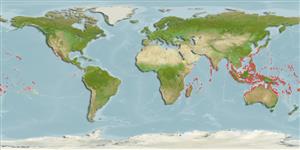Common names from other countries
Environment: milieu / climate zone / depth range / distribution range
Ecologia
Associadas(os) a recifes; intervalo de profundidade 0 - 30 m (Ref. 96667). Tropical
Indo-Pacific: Cocos Islands to French Polynesia and Hawaii.
Length at first maturity / Tamanho / Peso / Idade
Maturity: Lm ? range ? - ? cm Max length : 18.0 cm CW macho/indeterminado; (Ref. 343)
Carapace ovate; dorsal surface very smooth and convex. Color: cream to pink ground color, with 9 large violet to maroon spots on dorsal surface of carapace: 3 on median region, 2 on posterior region, 2 on anterolateral region, and 2 around orbits.
Maximum depth from Ref. 122032. Collected extensively for food (Ref. 343). Marginal levels of toxicity were detected in this species which may contribute to human poisoning (Ref. 107779). Inhabits reefs. Benthic (Ref. 343). Subtidal (Ref. 106854). Subtropical and tropical climates (Ref. 343). Nocturnal. Crushes other crustaceans and snails (Ref. 122680). Feeds on marine snails (Ref. 85383).
Life cycle and mating behavior
Maturidade | Reprodução | Desova | Ovos | Fecundidade | Larvas
Members of the order Decapoda are mostly gonochoric. Mating behavior: Precopulatory courtship ritual is common (through olfactory and tactile cues); usually indirect sperm transfer.
Ng, P.K.L. 1998. (Ref. 343)
Categoria na Lista Vermelha da IUCN (Ref. 130435)
Categoria CITES (Ref. 108899)
Not Evaluated
Not Evaluated
Ameaça para o homem
Poisonous to eat (Ref. 107779)
Utilização humana
Pescarias: espécies comerciais
| FishSource | Sea Around Us
Ferramentas
Mais informação
Idade/TamanhoCrescimentoComprimento-pesoComprimento-comprimentoMorfologiaLarvasAbundância
Fontes da internet
Estimates based on models
Preferred temperature
(Ref.
115969): 24.4 - 29.3, mean 28.4 (based on 3402 cells).
Vulnerabilidade
Low vulnerability (10 of 100).
Categoria de preço
Unknown.
